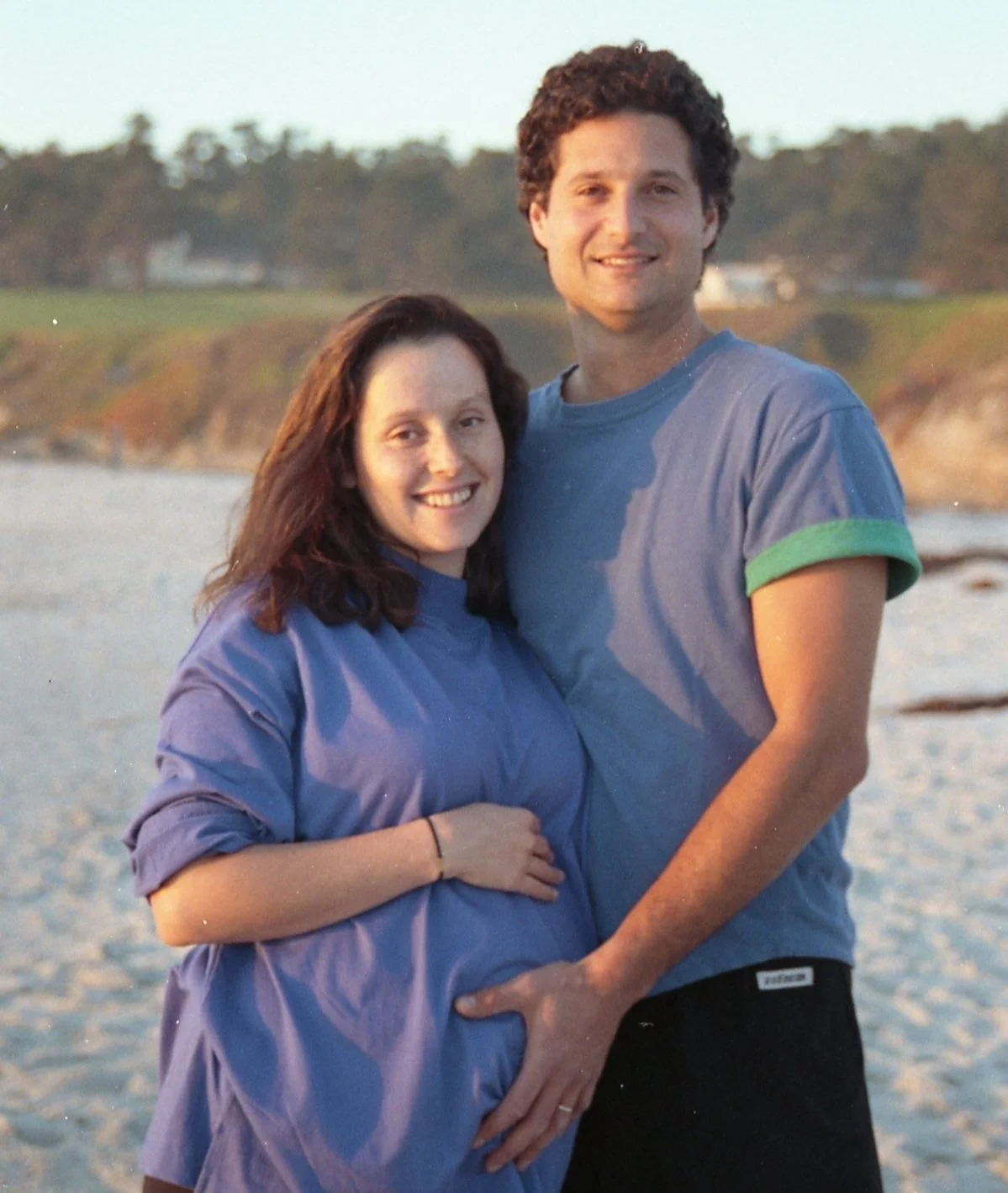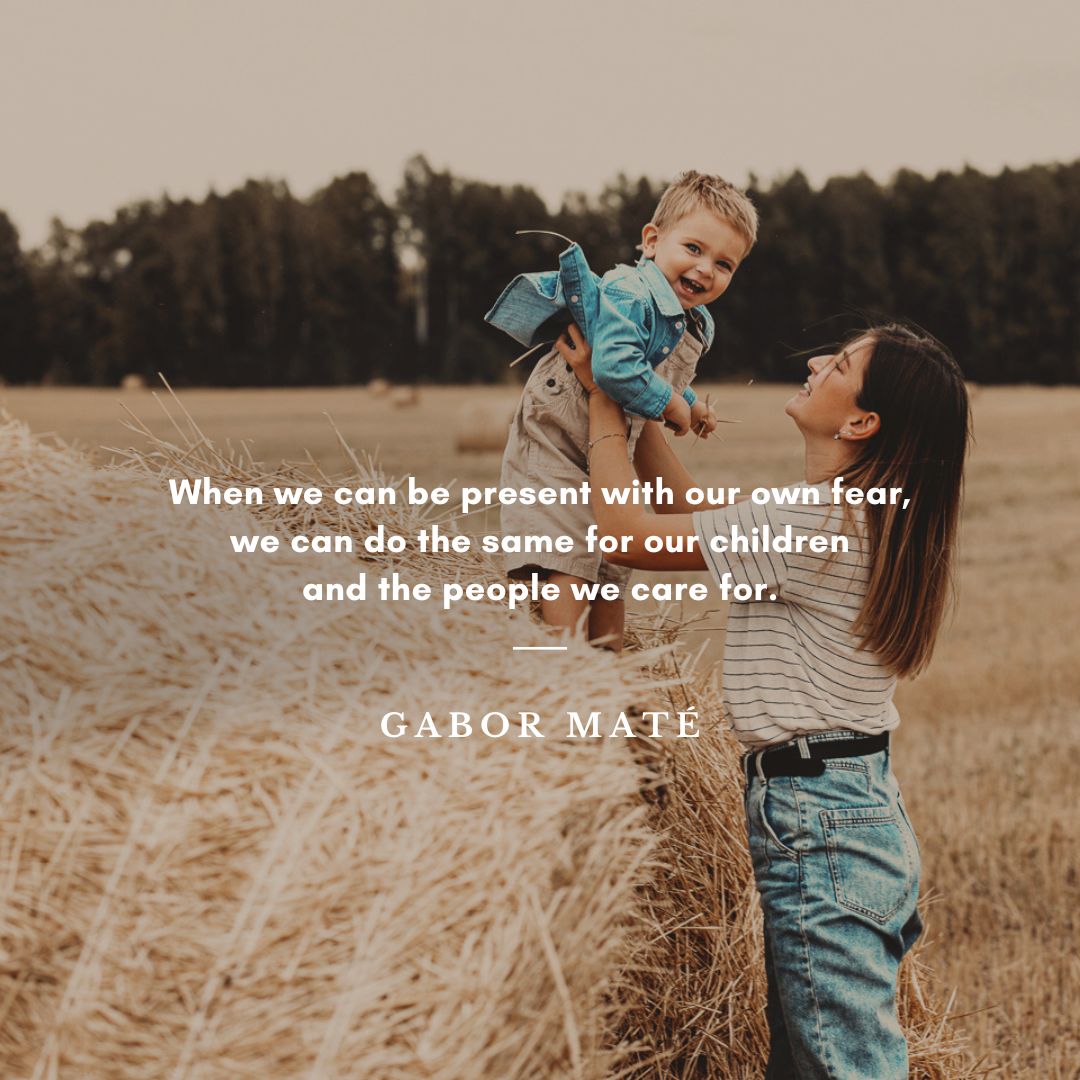Mothering Every Part of Ourselves
When I was 25 and pregnant with my first child, it became clear that I had to deal with my constant fear of an impending catastrophe. I’d been plagued by intense anxiety for as long as I could remember, but it was becoming increasingly difficult to manage. Unremitting worry that something would go horribly wrong with my baby was swelling along with my belly. Desperately wanting to find relief so I could enjoy motherhood and not pass my painful patterns down to my children, I began to see a therapist.
Myra and her husband Drew, circa December 1989
Unfortunately, I wasn’t able to make any progress in those talk therapy sessions, which left me feeling hopelessly neurotic and ashamed. But now I understand that my therapist never deciphered that my nervous system was stuck in a frozen state of hypervigilance. My fear lived in my body as well as my mind, so to heal I needed a “bottom up” somatic approach, not a purely a “top down” mental one.
It would take twenty more years for me to experience my first moments of being alive without the constant buzz of terror as my backdrop. At 45, while resting after a session with a remarkable healer in Tucson, Arizona who’d helped me connect with experiences that went as back as being in my mother’s womb, I felt truly safe and relaxed—fully present in my body for the first time. This blissful state didn’t last long, but it became the North Star of my healing journey.
Why was I always so fearful? I believe an essential root is the deep terror of violence and extermination that was passed down to me from my Holocaust survivor parents. My father, born to a Jewish family in Poland between the two world wars, wrote that as soon as he took his first breath, he began absorbing deep, ancient fears “like a dry sponge dropped in water.”
Myra (left) with her mother Edith and sister Ruthie, circa January 1964
Long after the war ended, my parents continued to live in a state of repressed fear, grief and pain, never speaking about the atrocities they endured, even to each other. It’s not surprising that neither of my parents were capable of offering their children an emotional refuge of calm and security. My mother worried constantly, as if worrying was her primary responsibility as a parent. Despite this atmosphere of suffering, uncomfortable feelings were considered a tragedy in our household, illness and pain a cause for hysteria.
After a childhood filled with many frightful experiences that overwhelmed my ability to cope, I became an unsupervised teenager in Manhattan so accustomed to feeling fear that it no longer worked as a warning system to help keep me out of danger. As an adult, my nervous system already in overdrive, I lived life at a hyper speed, pushing myself past my limits, always running to the next thing to complete my endless to-do list. The word “rest” was not in my vocabulary.
I’ve only recently realized that my excessively busy life and racing mind has been the primary way I’ve avoided feeling my difficult emotions. A huge part of my healing journey has been about developing the ability to turn towards my feelings with my full attention while comforting myself with kindness and compassion, just as a healthy mother would do for her beloved child. This has changed everything.
Myra with her daughter Marea, May 1990
I shared all of the above so you can understand why I was so excited when a popular podcast, The Happiness Lab with Dr. Laurie Santos (a Yale professor who studies science of happiness) devoted her whole last season to “why you should listen to those painful and difficult feelings.” For the episode that focused on anxiety, Dr. Santos featured Andrea Wachter, a psychotherapist who specializes in tools to ease anxiety. I was so impressed with Andrea’s knowledge, perspective and approach that I reached out to see if she was willing to collaborate with me on a Quest for Eternal Shine workshop and an article for Spirituality & Health magazine. Happily, she agreed!
It turns out that live workshops with Andrea are extremely rare. Her private practice is full, and she focuses her time on pre-recorded classes and meditations for Insight Timer (which are so popular, they’ve been downloaded over 3 million times!), so please take advantage of this unique opportunity and join us next Saturday, May 14, for our free “Quest for Calm—Practices to Ease Anxiety” event, and/or share the information with anyone you think could benefit.
Next week’s newsletter will feature the article Andrea and I collaborated on, but today, in this Mother’s Day newsletter, I want to offer you an anti-anxiety tool Andrea teaches called Self-Havening. This delightful somatic practice has become my go-to response as soon as I sense any stress, overwhelm, or anxiety begin to build, and it works every time. It’s a wonderful way to mother ourselves any time, and also an easy, empowering practice to teach our children and grandchildren. I hope you find it as enjoyable and effective as I do. Happy Mother’s Day!
Self-Havening
A somatic practice of comforting self-touch
Self-Havening was developed by neuroscientist Dr. Ronald Ruden, who discovered that when we gently stroke three specific parts of our bodies with the intent to impart comfort, a tremendous amount of calming neurotransmitters and happy hormones are released which interrupt the cycle of stress and anxiety by making us feel soothed and relaxed. Try experimenting with all three parts of your body to see which you enjoy most. You can alternate between them all, or just pick a favorite one or two. Try these methods for five to ten minutes, and notice how much better you feel!
Upper arms
Cross your arms over your chest, placing your left hand on your right shoulder and your right hand on your left shoulder, as if you’re giving yourself a hug. Lovingly stroke down from the top of your shoulders along the outside of your arms to your elbows, repeating over and over, at a pace and pressure that feels the most comforting.
Palms of the hands
Stroke and caress the palms of your hands in a gentle, loving way, using any pattern or rhythm that feels best.
Sides of the face
With one hand on either side of your face, stroke down from your forehead along your hairline in loving, gentle movements.
Try to stay as fully present as you can while practicing Self-Havening. As soon as you notice your mind wandering, bring it back to your body’s sensations.
You can enhance the effects of the Self-Havening touch by adding in a few deep breaths—inhaling through your nose and releasing tension as you exhale through your mouth. Try speaking soothing words to yourself, such as “All is well,” “I am safe,” “I am calm,” “I am strong and healthy.” You can also make soothing “shhh” sounds, hum, release loud sighs on your exhales, or visualize yourself safe and happily relaxing in any beautiful environment your imagination can create.






